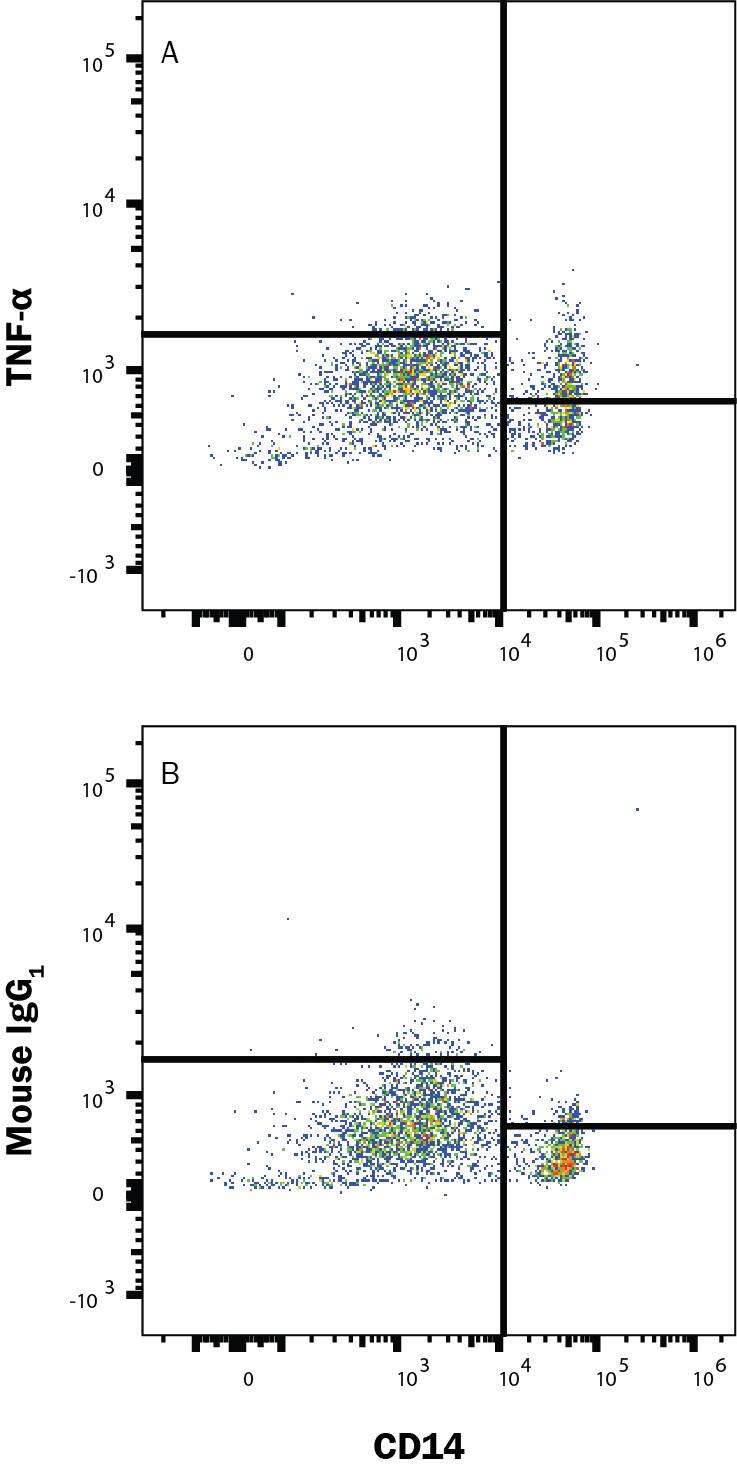Human TNF-alpha Membrane Form Fluorescein-conjugated Antibody
R&D Systems, part of Bio-Techne | Catalog # FAB210F


Conjugate
Catalog #
Key Product Details
Validated by
Biological Validation
Species Reactivity
Validated:
Human
Cited:
Human
Applications
Validated:
Flow Cytometry
Cited:
Flow Cytometry
Label
Fluorescein (Excitation = 488 nm, Emission = 515-545 nm)
Antibody Source
Monoclonal Mouse IgG1 Clone # 6401
Product Specifications
Immunogen
E. coli-derived recombinant human TNF-alpha
Gly57-Leu233 (predicted)
Accession # P01375
Gly57-Leu233 (predicted)
Accession # P01375
Specificity
Detects cell surface expressed TNF-alpha (membrane and receptor bound forms) by flow cytometry. Detects human TNF-alpha in direct ELISAs and Western blots. In direct ELISAs, approximately 25‑50% cross‑reactivity with recombinant porcine TNF‑ alpha and recombinant rhesus macaque TNF-alpha is observed but no cross-reactivity with recombinant cotton rat TNF‑ alpha, recombinant rat TNF‑ alpha, recombinant human (rh) LT alpha1/ beta2, rhLT alpha2/ beta1, rhAPRIL, rhBAFF, rhEDA‑A2, recombinant mouse EDA, rhFas Ligand, rhLIGHT, rhOX40 Ligand, rhTRAIL, rhTRANCE, rhTWEAK, or rhVEGI is observed.
Clonality
Monoclonal
Host
Mouse
Isotype
IgG1
Scientific Data Images for Human TNF-alpha Membrane Form Fluorescein-conjugated Antibody
Detection of TNF-alpha in PBMC monocytes by Flow Cytometry.
Stimulated PBMC monocytes treated with 1 μg/mL LPS at 37 degrees Celsius for 4 hours were stained with Mouse Anti-Human CD14 APC-conjugated Monoclonal Antibody (Catalog # FAB3832A) and either (A) Mouse Anti-Human TNF-alpha Membrane Form Fluorescein-conjugated Monoclonal Antibody (Catalog # FAB210F) or (B) Mouse IgG1 Fluorescein Isotype Control (Catalog # IC002F). View our protocol for Staining Membrane-associated Proteins.Applications for Human TNF-alpha Membrane Form Fluorescein-conjugated Antibody
Application
Recommended Usage
Flow Cytometry
10 µL/106 cells
Sample: Human peripheral blood monocytes and stimulated PBMC monocytes treated with 100 ng/mL LPS at 37 degrees Celsius for 4 hours
Sample: Human peripheral blood monocytes and stimulated PBMC monocytes treated with 100 ng/mL LPS at 37 degrees Celsius for 4 hours
Reviewed Applications
Read 1 review rated 5 using FAB210F in the following applications:
Formulation, Preparation, and Storage
Purification
Protein A or G purified from ascites
Formulation
Supplied in a saline solution containing BSA and Sodium Azide.
Shipping
The product is shipped with polar packs. Upon receipt, store it immediately at the temperature recommended below.
Stability & Storage
Protect from light. Do not freeze.
- 12 months from date of receipt, 2 to 8 °C as supplied.
Background: TNF-alpha
Long Name
Tumor Necrosis Factor alpha
Alternate Names
Cachetin, DIF, TNF, TNF-A, TNFA, TNFalpha, TNFG1F, TNFSF1A, TNFSF2
Entrez Gene IDs
Gene Symbol
TNF
UniProt
Additional TNF-alpha Products
Product Documents for Human TNF-alpha Membrane Form Fluorescein-conjugated Antibody
Product Specific Notices for Human TNF-alpha Membrane Form Fluorescein-conjugated Antibody
For research use only
